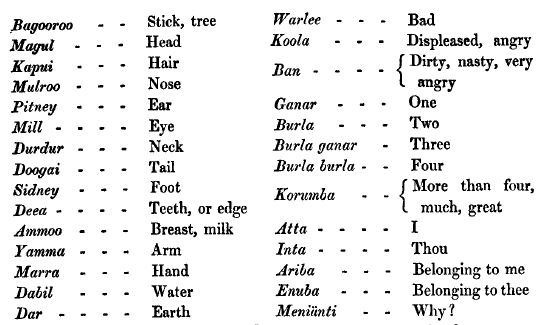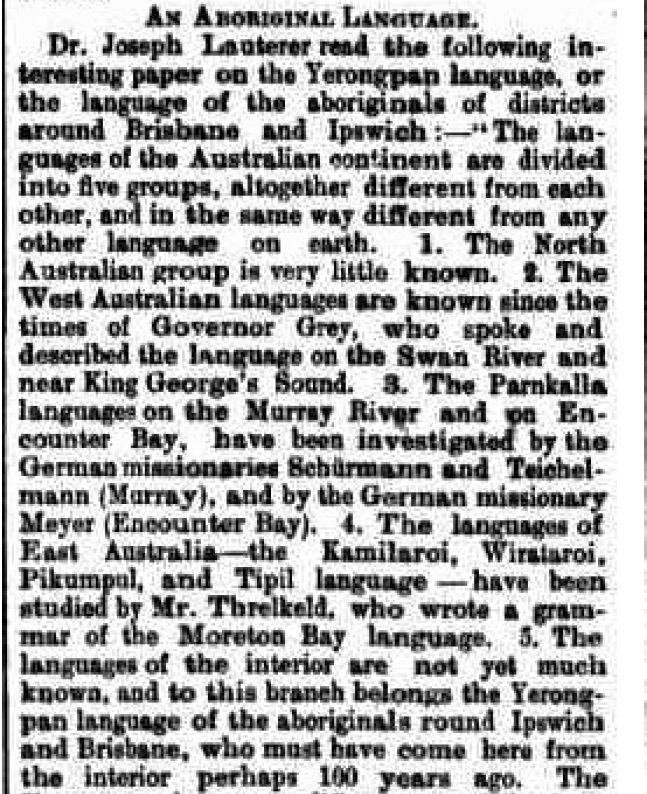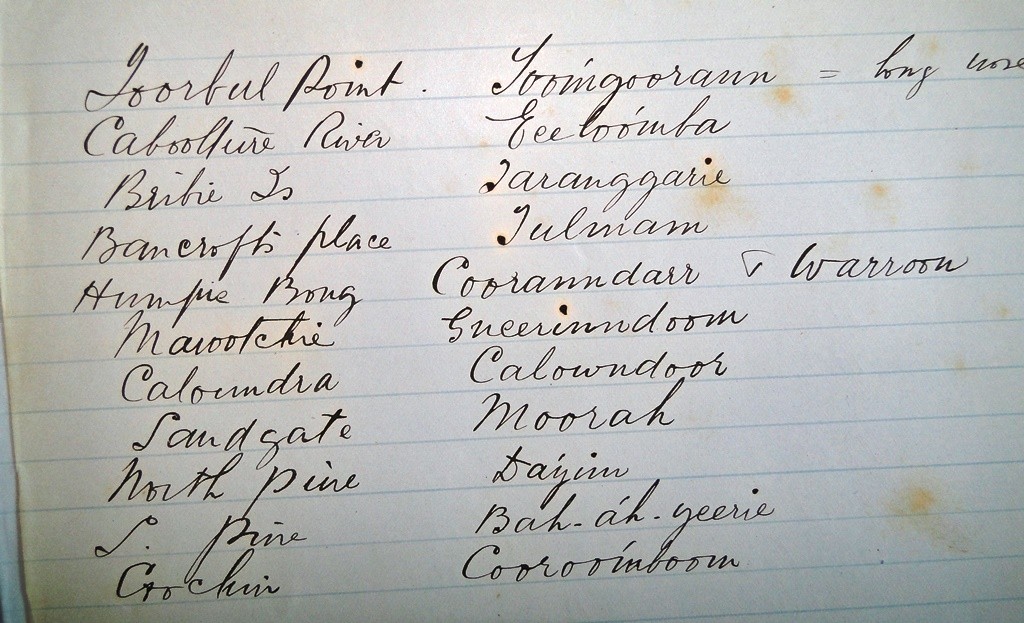At State Library we receive numerous requests on the languages of the Greater Brisbane Area; whether this be about language groups or particular words and their meanings. To assist in such enquiries, State Library has recently developed an Info Guide which provides a snapshot of Brisbane languages as well as directing researchers to items in the collections. This blog post will touch upon some of the information contained in the guide.

Native Language of the Moreton Bay Blacks, Edward Finch, 1842
Moreton Bay Colony had a very early contact history with wordlists collected in the 1820's by the convict Pamphlett and the explorer Thomas Mitchell. The above image is an extract of a vocabulary list recorded by Edward Finch in 1842 at Moreton Bay. Unfortunately the name of the particular language is not recorded but is believed to be from Yugara or Turubul.

In 1841, Christopher Eipper compiled a report on the German Mission at Nundah which included the above vocabulary; Eipper also identified the following tribes: Amity Point, Malurbine and Moppe’s tribes on the right bank of the river and the Duke of York’s, Pine River, Ninge Ninge, Umpie Boang and Yun Monday tribes (Eipper, pp. 4-5). This document is one of the first accounts of the different tribes who lived in the Greater Brisbane Area.

Joseph Lauterer: Yerongpan dialect
While historically there has been much written about the Aboriginal peoples of the Greater Brisbane area, there still exists uncertainty around languages and dialects as well as their structure and relationship. Furthermore, there is even greater ambiguity surrounding the boundaries and extent these languages and dialects were originally spoken. Meston, Ridley, Welsby, Lauterer and others debated the nature of Brisbane/Moreton Bay languages, often quite publicly in the pages of the Moreton Bay Courier and other newspapers of the time. In March 1891, Dr Joseph Lauterer read a paper at the Royal Society of Queensland meeting on the 'Yerongpan Dialect of the Sandy Country between Brisbane and Ipswich', from present-day Yerongpilly and Rocklea region - the extract above also included a short vocabulary list which was promptly disputed by Meston!

Archibald Meston documented quite a bit of language and cultural material on the Greater Brisbane Area, including the above list of placenames which can be found in the Meston notebooks, OM64-17. Frederick Watson in the 1940's collated historical information to create his Vocabularies of four representative tribes of South Eastern Queensland - he groups the Brisbane languages under the umbrella term of Yugarabul. Included in his collection - Frederick James Watson papers, OM73-20 is a map which attempts to identify the areas where the four main languages were spoken.

Frederick James Watson Map, 1941, OM73-20, F J Watson papers, State Library of Queensland
Historical and linguistic texts within the State Library collections identify a range of languages or dialects spoken across the region; these are listed below:
Brisbane CBD
- Turrbal – also written as Turubul, Churrabool, etc.
- Jagera – also written as Jagara, Yuggera, etc.
Brisbane South
- Coorparoo – (believed to be a clan group)
- Chepara – also written as Tjipera (believed to be a clan group)
Yerongpan – also written as Yerongban or Yeronghan
- Bayside - South
Goenpul – also written as Goinbal
- Gnaloongpin – also known as Malurbine (believed to be a clan group)
Logan River – Beenleigh
- Yugambeh and related dialects, including Gugingin, Bullongin, Kombumerri, Mingunburri, Birinburra
Gold Coast
- Minjungbal - also written as Minyangbal or Minjangbal
- Kombumerri - also written as Kombumeri
- Ngarahngwal - also written as Ngarahgwal or Ngaraangbal
Beaudesert
- Manaldjahli - also written as Mununjali
Brisbane West
- Garumngar – also written as Garumnga
Ipswich & West Moreton
- Jagara – also written as Yagara
- Yugarabul – also written as Yuggarabul
- Yuggera – also written as Jagara
Brisbane North
- Turrbal – also written as Turubul, etc.
- Ningy Ningy – also written as Ninghi Ninghi
- Duungidjawu – also written as Dungidjau
Bayside - North
- Undanbi – also written as Undumbi
Moreton Bay
- Jandai – also written as Jandewal or Djendewal
- Nunukul – also written as Noonuccal
- Moondjan – also written as Moonjan
- Ngugi – also written as Gnoogee
- Guwar – also written as Goowar or Guar
Sunshine Coast
- Kabi Kabi – also written as Gubbi Gubbi
- Joondaburri – also written as Djindubari
Note:
Ford and Blake (1998, p.11) identify the following alternative spellings for Brisbane Aboriginal groups:
Yugerra, Yagara, Yaggara, Yugg-ari, Yackarabul, Turubul, Turrabal, Turrubul, Turrabal, Terabul, Torbul, Turibul, Toorbal, Yerongban, Yeronghan, Ugarapul, Yerongpan, Biriin, Ninghi, Ningy Ningy, Duke of York Clan, Jaarabal, Jergarbal.
AIATSIS Language Codes

The above information provides an insight into the cultural diversity of the Brisbane area – there was a fair degree of interaction among groups for ceremonies, trade and other social gatherings. Most languages are based on drainage systems and the associated catchment area. In the Greater Brisbane area, this included Brisbane River; Logan River; Albert River; Bremer River; Pine River; Warrill Creek; Moggill Creek; Teviot Brook and Tingalpa Creek.

Generally speaking, the languages of Brisbane are related with many shared/borrowed words; and traditionally individuals spoke several languages including their parents’ languages and neighbouring languages. The languages to the north of Brisbane CBD have a relationship to Kabi Kabi and Wakka Wakka; while the Moreton Bay and Brisbane area languages were linked; Yugambeh to the south of Brisbane shared more in common with Bundjalung.
The Information Guide will be a useful reference tool for community members, language workers and other researchers who wish to gain an insight into the complex and richly diverse landscape of Brisbane languages.
Desmond Crump, Indigenous Languages Coordinator, kuril dhagun
State Library of Queensland Indigenous Languages webpages
References and Further Reading
- Curr, E. M. (1887) The Australian Race: its origins, languages, customs, place of landing in Australia and the routes by which it spread itself over that continent. RBF 572.994 cur
- Colliver, F. S. (1986) Aboriginals in the Brisbane Area. PAM 994.30049915 1986
- Craig, W. W. (2007) Moreton Bay settlement, or, Queensland before separation, 1770-1859. QCFS 994.3 2007
- Eipper, C. & Lang, J. (1841) Statement of the origin, condition and prospects of the German mission to the Aborigines at Moreton Bay, conducted under the auspices of the Presbyterian Church in New South Wales. RBJ 266.529431 EPP
- Eipper, C. (2007) German Mission to the Aborigines at Moreton Bay, 1841. Archive CD Books. QCFS 266.02343094 2007
- Finch, C. W. (1842) Charles Wray Finch Papers 1842-1860 OM78-92/4
- Fisher, R. (Ed.) (1992) “Brisbane: The Aboriginal presence 1824-1860.” In Brisbane History Group. No. 11. J 994.31 BRI
- Ford, R. & Blake, T. (1998) Indigenous peoples of southeast Queensland: an annotated guide to ethno-historical sources. G 016.30589915 1998
- Holmer, N. (1983) Linguistic Survey of South-Eastern Queensland. J 499.15 HOL
- Kerkove, R. (1985) West End to Woolloongabba: the early and aboriginal history of a district. VF 994.31 ker
- Kite, S. and Wurm, S. (2004) The Duungidjawu language of southeast Queensland: grammar, texts and vocabulary: Pacific Linguistics 553. J 499.15 KIT
- Meston, A. (undated) Archibald Meston Papers Undated. OM64-17
- Pamphlett, T. and Uniacke, J. (19--) Narrative of Thomas Pamphlett, aged thirty-four years, who was with two other men wrecked on the coast of New Holland in April 1923 and lived among the natives for seven months. VF 910.453 pam
- Ridley, W. FILM 0705
- Ridley, W. (1855) W Ridley Notebook, 1855. OM79-32/17
- Ridley, W. (1866) Kamilaroi, Dippil and Turrabul: languages spoken by Australian Aborigines. RBJ 499.15 rid
- Sharpe, M. (1998) Dictionary of Yugambeh, including neighbouring dialects, compiled by Margaret Sharpe from various sources: Pacific Linguistics C-139. G 499.15 1998
- Watson, F. J. (1944) “Vocabularies of four representative tribes of South Eastern Queensland”; supplement to the Journal of the Royal Geographical Society of Australasia (Queensland), No. 34, Vol XLVIII. REFJ 499.15 wat
- Watson, F. J. (1941) F J Watson Papers 1941 OM73-20
- Welsby, T. (1916) “Recollections of the Natives of Moreton Bay together with some of their names and customs of living.” (Typescript) 6758 Box 11392.
Comments
Your email address will not be published.
We welcome relevant, respectful comments.